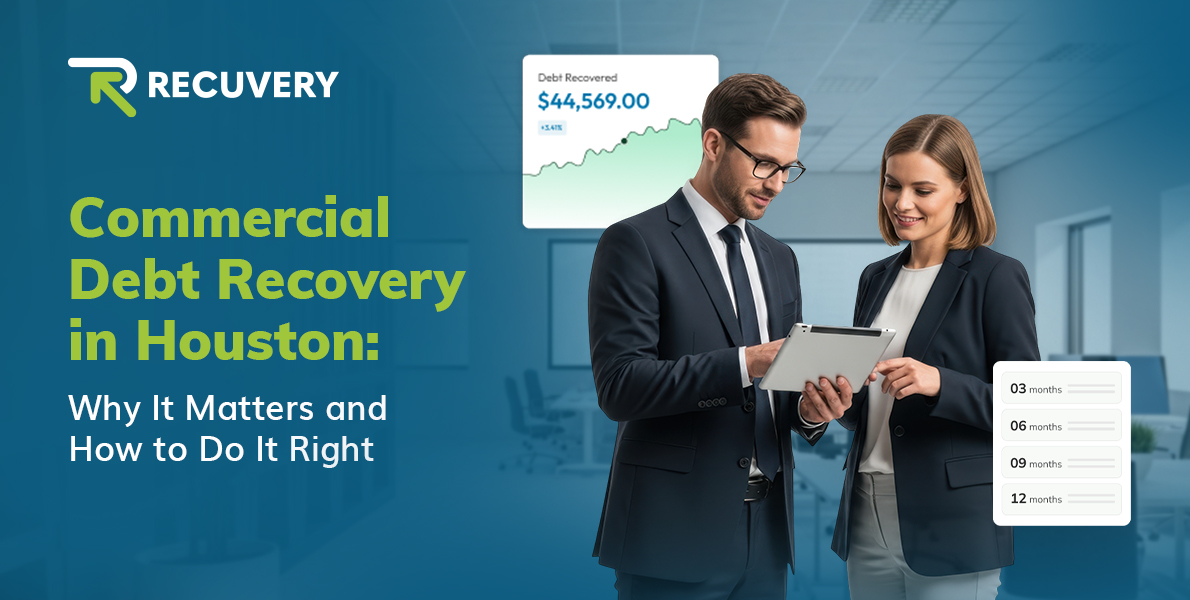Debt Recovery for Businesses: Challenges & Strategies

Consistent cash flow is critical to a business’s financial sustainability. However, unpaid invoices, i.e., uncollected revenue, can put a strain on your business’s financial resilience. 81% of unpaid invoices that are past due for over 21 days are at greater risk of turning into lost revenue.
In fact, more than 80% of businesses lose 10% to 20% of their revenue to bad debt. It affects small and mid-size businesses more, as it can consume a lot of time, money, and resources that the business owners may otherwise have used for productive operations.
In this blog, we’ll analyze the common challenges related to debt recovery for businesses and the cutting-edge debt collection software and strategies to eliminate those challenges while optimizing debt recovery efficiency.
Challenges with Existing Debt Collection Methods
1. Time-Consuming Processes
On average, small and medium-sized businesses lose around 30 or more hours chasing late payments per month. For in-house teams, this can make a significant difference, as valuable time and resources have to be diverted from running the business.
2. Errors and Wrong Info
Mistakes like wrong names or contact numbers on invoices, etc., can delay the collection process or render them unenforceable. Without proper documentation of debt owed, businesses can lose out on successful debt recovery.
3. Lack of Payment Options
When repayment terms aren’t clearly outlined as a clear agreement, disputes are more likely to arise. Verbal agreements or vague contracts weaken a business’s ability to legally enforce timely payments. Moreover, when customers are requested to repay the total amount owed on short notice, it’s usually not feasible for most.
4. Inconsistently Following Debt Recovery Practices
Internal debt collection teams often have a hard time correctly and consistently following the Fair Debt Collection Practices Act (FDCPA) regulations due to a lack of expertise.
Without a defined process for handling overdue accounts and consistent follow-ups, recovery delays cannot be helped. This results in missed opportunities for recovery and poor financial management over time.
5. Risk of Damaging Customer Relationships
If the customers are pushed too hard for payments, it might encourage more customers in their local community to avoid future business with that particular business.
On the other hand, a soft approach can lead to repeated late payments and weaken the business’s financial position. Therefore, businesses require a delicate, balanced approach that ensures customers have a fair opportunity to repay the debt without damaging the customer relationship. This can be possible by adopting automated debt recovery solutions.
6. Limitations of Hiring Collection Agencies
Hiring an outside debt collector business can be more costly for mid-size and small businesses than handling collections on their own. This is because most collection agencies charge 20% to 50% or more as their commission, depending on the complexity. This leaves very little in recovered amount for the small business.
Additionally, collection agencies may ignore hard-to-recover accounts, especially the oldest late payers. Delaying firmer action reduces the likelihood of getting paid and allows bad debt to grow, making it harder to collect.
7. Mental Strain and Ineffectiveness
Dealing with unpaid invoices is frustrating and stressful, especially when clients avoid communication. It takes an emotional toll that can impact morale and lead to burnout, especially in internal teams. This adds to the ineffectiveness of recovery efforts.
8. Low Success with Persistent Defaulters
When a customer consistently avoids payment or goes silent, collection efforts often reach a dead end. Those debts are rarely recovered, which often leads to financial losses.
Struggling with Outdated Processes and Low Debt Collection Rates? See How Recuvery Can Help.
How Does Automated Debt Collection Software Work?
For businesses that want to save their time and resources and eliminate the manual processes associated with collection hassle, implementing an automated debt recovery solution is the best move. For instance, debt recovery software like Recuvery automates the collection process with minimal effort. Here’s how it works:
Step 1: Enter Customer Details
Getting started is relatively easy, as no special integration is required. Simply create your account and upload the personal details of all your past-due customer accounts. To make things easier, you can upload the overdue accounts receivable list as a Google Drive or Excel sheet. This way, you won’t need to enter the details of each customer manually.
Step 2: Automated Collection
Once you have uploaded the list with all the past-due invoices, the automated system will handle the rest. It will send automated reminders, timely follow-ups, offer different repayment options to customers, and keep track of payments when customers start repayment. You can track the efficiency of your collection efforts from a centralized dashboard with key analytics.
Step 3: Efficient Recovery
As the automated debt collection gains momentum, you can start receiving recurring payments from customers. This saves time and effort while enhancing recovery efficiency at a fraction of the cost of what you’d otherwise spend on the traditional collection methods.
Impact of Automated Debt Recovery for Businesses
► Flexible Repayment Plans
Offering flexible payment plans makes it easier for customers to repay in smaller, manageable installments. This reduces friction, minimizes disputes, and increases the likelihood of full repayment over time without overwhelming customers.
► Customer-Friendly Payment Approach
Automated reminders and flexible repayment options allow businesses to collect payments while maintaining positive customer relationships. It shows empathy while still enforcing payment commitments.
► Higher Recovery Rate
The streamlined approach reduces manual hassle and human errors and ensures each debt is well-documented for efficient recovery. Additionally, the data-driven approach boosts recovery from even the most difficult accounts.
► Structured & Consistent Process
The systems follow a set schedule for communications and escalations. This ensures that every overdue account is handled consistently, improving recovery rates and keeping cash flow predictable.
► Cost-Effective Debt Recovery
Automated debt recovery eliminates the need to outsource to expensive collection agencies. Businesses can recover more of their money without losing up to 50% in commission fees, maximizing the return on every collection.
► Saves Time
Implementing debt collection software can significantly reduce the manual effort required to follow up on overdue payments. Automated reminders, follow-ups, and payment tracking can run in the background.
► Less Stress, More Control
This approach also removes the emotional burden on the staff by taking over repetitive and stressful follow-ups. Meanwhile, business owners gain peace of mind with real-time insights into recovery progress and account activity.

See How Automated Debt Collection Can Boost Your Debt Recovery Rates
Read Our GuideBottom Line
Heavily relying on traditional collection methods can be counterproductive in more ways than one. They often require more money, time, and effort; that’s why automating debt collection with a debt recovery solution is the smart move for your business. If you haven’t taken this step yet, Recuvery can help you do so with ease. It seamlessly integrates into your process, making past-due recovery effortless.
Insights & Answers to Top Queries on Automated Debt Collection Software
1) What Is Automated Debt Collection Software?
Automated debt collection software helps businesses streamline the recovery of unpaid invoices. It uses automated reminders, timely follow-ups, payment tracking, tailored repayment options, and data-driven reporting. Hence, reducing the need for manual intervention and increasing recovery efficiency.
2) How Is Automated Debt Collection Better Than Traditional Methods?
Unlike manual processes or third-party agencies, automated tools are faster, more consistent, cost-effective, and less prone to human error. They help recover more money while saving time and protecting customer relationships.
3) Is It More Affordable Than Hiring a Debt Collector Business?
Yes. Automated solutions eliminate the hefty commission fees (20–50%) that you may typically need to pay collection agencies. Hence, businesses can retain more of the recovered amount at little cost.
4) Is Automated Debt Recovery Compliant with Debt Recovery Regulations?
Yes. Recuvery is a reputable platform that follows the regulatory guidelines under the Fair Debt Collection Practices Act (FDCPA). It follows transparent communication processes to ensure compliance and avoid legal compliance risks.
Want to Reduce Manual Work and Automate Your Collections?






